List of Authors
>>About this blog
Recent blog post
|
[Yuyama also only]
May 20, 2014 14:00
On this Sunday, I went to "Oji Hall" behind Ginza Mitsukoshi for the first time in a long time.
I've visited several times, but most of them are weekday night performances, and this is the first time Matinee performance.
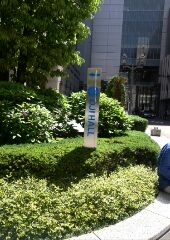
The main street of Ginza is a pedestrian paradise. For that reason, the back street is full of cars. In front of Asahi Inari Shrine, there was also a rosary.
By the way, this shrine is very unique, with a pipe connected to shrine hall on the roof of the building, and it is erected on the roof so that you can hear the sound of a bell.
When I went around a shrine in Ginza with a friend, I experimented whether it could be heard separately on the rooftop and on the ground, but in the surrounding sounds ...?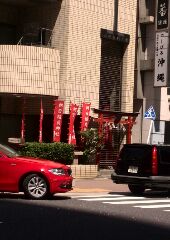
The recently renewed "Oji Hall" has been around since I was a child. And I was taken by my mother who was enthusiastic about emotional education, and I didn't remember well, but I visited recital, a foreign pianist.
At the piano classroom I attended at that time, there were presentations about once or twice a year, and it was held at the Yamaha Hall or the now deceased Gas Hall.
Students in the same classroom had a dress made of the same fabric in various designs by a clothes shop and appeared.
A collarless style with a tule or lace on the chest. And always there is a big sash ribbon behind the waist.
I have an exciting memory for my child.
And
"The presentation will be held at Yamaha Hall, and when I become a professional, I will do it at Oji Hall."
I thought it was.
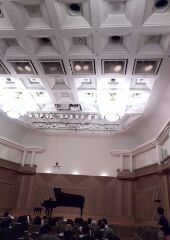
By the way, the protagonist of the day is "60th birthday (!?) recital" once in a lifetime. He performed the best singing ever.
The hall was luxurious, and the four costumes were very nice.
He has the daughter of an opera singer (but not sold). Every time I return to Japan several times, I would like to make a hurried reservation for the venue and pray that recital in the ward hall, which is set up by my family, will be held at Oji Hall in Ginza! ?
It was 2 hours while immersing in such memories.
[Ryokichi]
May 20, 2014 09:00
This time, I went jogging in search of the Nihonbashi River, an important river in Chuo-ku, and the headwater of the Kanda River.
Actually, it has been long since I left Chuo-ku, so I will report it compactly.
The start is Toyomi Bridge, where the Nihonbashi River collides with the Sumida River. It is a unique bridge that looks like a ladder is turned sideways.
It has the same thickness as the powerful Eitai Bridge nearby.
From there, there is no road along the river, so I decided to go along the road running parallel to the river as much as possible.
We will proceed with Minato Bridge, Kayaba Bridge, Armor Bridge, Edobashi, Nihonbashi ...
The former Joban Bridge was under construction. Chuo-ku is over at Shin Tokiwa Bridge.
The river so far is mostly under the highway, so it is an image of an urban river. (The photo shows the former Joban Bridge under construction)

Even in Chiyoda-ku, we will continue to be covered by expressways. I collide with the Kanda River at the Suidobashi. From there, it is the Kanda River. I'm going on with Iidabashi, Edogawabashi, Waseda, and Takadanobaba. The river goes as a city river with a hardened revetment. The promenade along the river is gradually getting ready. The river meanders and comes close to the skyscrapers in Shinjuku. This area is Nakano-ku.
When you go to Suginami-ku, the expression or atmosphere gradually changes. First of all, the greenery along the river increases. Fish and birds are also often seen. As you proceed along the Inokashira Line, you will see the goal. I feel tranquility. Yes, the goal is Inokashirakoen. There were lots of people on a sunny weekend.
(Photo: Inokashirakoen)
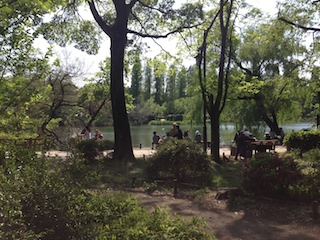
I realized on my own feet that the water in the pond of Inokashirakoen spilled out and that part of the water came to Nihonbashi. It was about 25 km away.
Because it was a hot day, I gave up on the return trip and decided to return on a public vehicle from here. After sweating at the public bath in Kichijoji and refreshing, it became a comfortable house.
[kimitaku]
May 18, 2014 17:00
Recently, you can see a new bridge downstream of Kachidokibashi.
It is colored with a silver lineage, and the contrast with the blue color of the water surface is wonderful.
The Shiodome skyscraper is also beautiful in the distance.
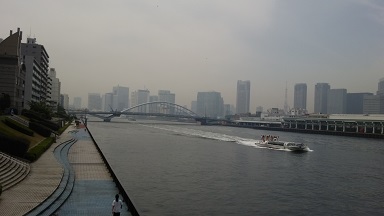
It was recently bridged as an extension of this bridge, Loop Route 2.
It seems that the opening is still ahead, but it is wonderful with a silhouette that is very similar to Kachidokibashi that I have so far.
Construction of Loop Route 2 (MacArthur Road) is underway at a rapid pace from Ariake, Koto-ku to Shin Toyosu (wholesale market is under construction), Toyosu Ohashi, and Kachidoki, Chuo-ku.
Then cross the new bridge and connect from Tsukiji Market to Hamarikyu, and to Shimbashi, Toranomon, and Tameike.
It may be fun to take a walk while watching the changing Route 2 for the summer.
・・・ We are currently recruiting names for this bridge. ・・・
Application method is written on page 3 of "News of Ward" issued on April 21. The deadline is May 20th.
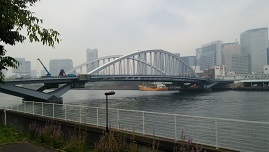 
[Mapo ★]
May 18, 2014 09:00
This year, a French food fair is being held on the 8th floor of Ginza Mitsukoshi.
It's until May twentieth and the last day ends at 17 o'clock.
When you go up the elevator, you can sell miscellaneous goods such as bags.
The first food sales floor is oil sardine.
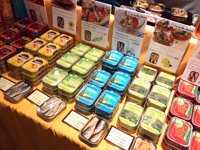 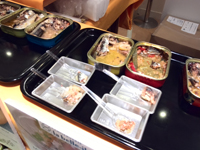
It's an oil serdin in the Pluttany region, from a company called La Bell Iroisers.
The taste was very rich, and I was able to taste all 9 kinds.
All of them were delicious, but I made it a little spicy Pimento flavor.
Click here for the website
And next is the mustard of Edmond Fallow for this purpose.
There are many kinds of mustards of Faroe.
I also sell it to Japan, but I went to buy a taste that I couldn't buy in Japan.
There was no pandemic, but there was a cassis, so I bought it.★
Click here for the website
And next is cheese. It's also in Nihonbashi Mitsukoshi, and the main store is in front of Suitengu-mae.
A shop called cheese on the table.
This time, I also tasted cheese specially imported for fairs.
I bought shavre (goat cheese) and blue cheese.★
Click here for the website

Next is the shops of Junbon (Ham) and Socison (Salami) in Byonne.
It was delicious, so I bought a ham.
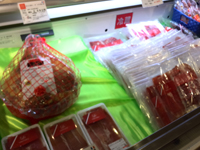
And let's go through the wine corner.
I've been drinking quite a lot of different kinds until now.
There are a lot of wines with labels that I have never seen before.
When I heard it, there are many wines that are sold only at hotels and restaurants.
It is also the real pleasure of the fair to buy such wine.
I tasted more than 10 kinds.
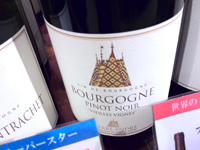 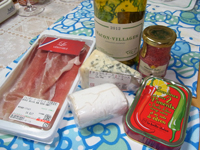
Sweets booths such as Essile Butter and Eskis Milfeuille were also exciting.
I will definitely go next year (*^^ *)
[Apricot peony]
May 17, 2014 14:00
The annual "East Odori" by the Geishas of Shimbashi is held.
This year will be held from May 24th to 27th.
It is a historic performance of 90 times in series, but it was originally started by Shimbashi geisha to show off first-class arts and improve the arts.
The venue, Shimbashi Enbujo, was originally built by geisha, officials of the Shimbashi Hanayanagi world, such as shops and restaurants, and their supporters.
So, even if the place is in Ginza, it's called "Shimbashi Enbujo".
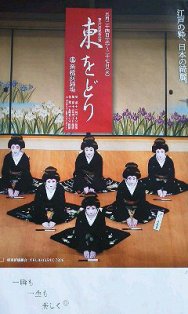 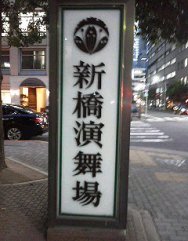
By the way, this "Shimbashi" of "Shimbashi Hanayanagikai" is now the place name of Minato-ku, so why is Chuo-ku? I think there are many people who think about it.
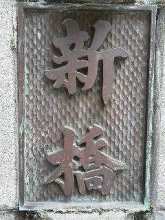
"Shimbashi" That's because the Shiodome River used to flow through the capital highway ahead of Ginza 8-chome, and it was the name of the bridge that took it there.
Even today, only the main pillar remains under the high speed.
At the end of the Tokugawa period, there was a female master who was teaching Jobanzu in Kinharumachi, which is now the back of Hakuhinkan, near it, and was often called to banquets such as restaurants nearby, and from the Shogunate I get the approval of "I'm going to get it.
This is said to be the beginning of "Shimbashi Geisha".
After the Meiji Restoration, it was favored by political and business people from Satsuma and Choshu, and was sometimes called "Shinyanagi Nibashi" along with Yanagibashi, a representative Hanayanagi world from the Edo period.
The Hanayanagi world, which can be said to be the ultimate of "Japanese hospitality", has recently been talked about, but it is still a world with a high threshold for ordinary people.
Especially for women, it seems that there is no connection if it is normal, but with this "east", you can enjoy such an atmosphere not only in the stage but also in the lobby and the theater as a whole.
For more information, please visit the following page.
http://www2.odn.ne.jp/shinbashikumiai/
 For those who want to know more about the Shimbashi Hanayanagi world, we recommend a book called "Meiko Qualifications-Hososho Shimbashi Yotan" (published by Yuzankaku in 2007). For those who want to know more about the Shimbashi Hanayanagi world, we recommend a book called "Meiko Qualifications-Hososho Shimbashi Yotan" (published by Yuzankaku in 2007).
The author, Naofumi Iwashita, came to Shimbashi Enbujo, but recently he has been active on TV and other media, and TBS TV's morning "Ippuku!" It's also featured.
The story from a former geisha who was known as "Kiyo-Sister" in this book is really interesting because the detailed customs and the customer's spirit are lively written.
[Shiraji]
May 16, 2014 14:00
"Good morning, sir,"
"Oh, bear-san, did you go somewhere to GW?"
"Yes, I've been caught by a oyster and have been staying at Fuji Five Lakes for one night by car."
"Well, it was good weather and the children would have been pleased." "I said by car, but wasn't it crowded along the way?"
"Yes, it was a bit congested at the Metropolitan Expressway, but I was able to run relatively smoothly. By the way, I found a little unfamiliar sign thanks to the traffic jam, and from the oysters, "What is that?" I was asked....」
"It was just above Nihonbashi heading for Shinjuku, and there was a" Nihonbashi Road Signpost ", so what do you know that? There is Nihonbashi right below, Nihonbashi is a Japanese loot, and it is a sign that Japan's roads have started from Nihonbashi since the Edo period! Even now, the word "Japan Road Mark" is embedded in the middle of Nihonbashi! "
When I said, "Dad, I know that in the social studies class, what I want to know is the" ah1 "sign written below!" It says Asian Highway, but ...?"...I'd like to ask you for your retirement....」

"Well, Kenbo was a big deal to notice that sign, yes, that AH1 is an abbreviation of Asian Highway Asia Highway No. 1, that is, the Asia Highway also starts in Nihonbashi."
The AH1 Asia Highway Route 1 is a long road over 20,000 km, starting from Nihonbashi in Japan (Tokyo) to Turkey via Korea, North Korea, China, Vietnam, Cambodia, Thailand, Myanmar, Bangladesh, India, Pakistan, Afghanistan, Afghanistan, Iran, etc.
"Japan is also known as the modern Silk Road that goes through the highway to Fukuoka, then by ferry to Busan, South Korea, and then passes through Eurasian Continent to Europe. However, North Korea cannot pass now, there are areas where it is difficult to pass in combat areas such as Afghanistan, and there are many areas where it can be said to be rivers when it rains unpaved, and there are many areas where it can be said that can be called highways that can't pass through highways that can't pass through such as highways that can't pass through the entire Asian roads that can't be passed on highways.
http://www.mlit.go.jp/kokusai/kokusai_tk3_000071.html (Asia Highway, Ministry of Land, Infrastructure, Transport and Tourism)
"Oh, I'd like to fly AH1 from Nihonbashi to Western Europe! But if it's 20,000 kilometers, it will take a month to Western Europe....」
"Yeah, I heard that the big husband of the dye shop 'Toraya' would never cross Nihonbashi?"
"Yeah, that person is also a stubborn, since the highway was built on Nihonbashi, "I don't care like a child straddling over the head of a parent whose car passes over my head!" says, "I don't want to cross Nihonbashi for a long time since the highway was built on Nihonbashi."
"No, I can understand that feeling, if I go over Ginza Street on the highway, I want to do a silver bra and it is thin!"
"By the way, why is the highway running right above Nihonbashi? You didn't have to go to such a place?"
Tokyo, which was destroyed by the war, gradually recovered, and the number of cars increased rapidly in Tokyo since the late 1950s, and the government decided to build an expressway in Tokyo in preparation for the Tokyo Olympics in 1964. However, in the city center, the river and the moat were constructed in the capital highways by reclaiming the roads and moats that were relatively easy to construct.
"Oh, when I was a kid, the Sumida River was dirty and smelly!"
"By the way, in the Edo period, you carried luggage by boat on rivers and moats instead of cars, right? If so, expressways take over old people's means of transportation in the present era! "
"Yes, in the town of Edo, moats and rivers ran vertically and horizontally, and a chokibune carrying boats and people came and went, and it was like Venice! In Tokyo during the high-growth period, even if rivers and moats were reclaimed, there were few oppositions because they were reclaimed, and it was an era when environmental rights such as landscape and sunshine rights were not often said! "
http://map.goo.ne.jp/map.php?MAP=E139.46.40.076N35.40.50.727&ZM=11&st=8 (Old Tokyo)
"Yes, if you said that you would pass a road over Nihonbashi right now, the scenery of protecting cultural properties will be bad, but a fierce opposition movement will occur and you will not be able to make a road!"
"But it's called the retirement, major earthquake directly below the capital, and the Metropolitan Expressway needs to be rebuilt 50 years after construction, right? How about returning to a moat or river as in the past, if you take it away all and move it underground? "
"Yes, underground is resistant to earthquakes, and construction costs may be incurred, but since the 'deep depth method' was established, compensation is not required in principle, so it may be realized unexpectedly early."
"If you do so, the great husband of the Tiger family may be able to cross Nihonbashi where you can see a heavenly path without a ceiling! I hope it will be realized while my husband is alive!"
"Yes, then Chuo-ku may be able to register with World Heritage as a town that preserves Edo culture!"
|
Links
|











 For those who want to know more about the Shimbashi Hanayanagi world, we recommend a book called "Meiko Qualifications-Hososho Shimbashi Yotan" (published by Yuzankaku in 2007).
For those who want to know more about the Shimbashi Hanayanagi world, we recommend a book called "Meiko Qualifications-Hososho Shimbashi Yotan" (published by Yuzankaku in 2007).

